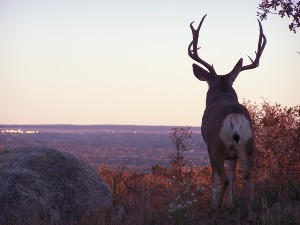 Mule deer, elk, and wild turkeys are plentiful in the park. It is not uncommon to observe these species roaming, feeding, and resting among scrub oaks, ponderosa pines or the abundant prairie grasses. Along the trails on the eastern edge of the park listen for the shrill barks of black-tailed prairie dogs as they warn other colony members of a strangers presence. Coyotes, foxes, and red-tailed hawks also keep a watchful eye on the prairie dogs hoping to swoop in and snatch a meal. Though not often seen, other predators like the black bear, bobcat, and mountain lion inhabit the park. Evidence of their presence can be detected by examining the tracks, scat, and other clues left along the trails.
Mule deer, elk, and wild turkeys are plentiful in the park. It is not uncommon to observe these species roaming, feeding, and resting among scrub oaks, ponderosa pines or the abundant prairie grasses. Along the trails on the eastern edge of the park listen for the shrill barks of black-tailed prairie dogs as they warn other colony members of a strangers presence. Coyotes, foxes, and red-tailed hawks also keep a watchful eye on the prairie dogs hoping to swoop in and snatch a meal. Though not often seen, other predators like the black bear, bobcat, and mountain lion inhabit the park. Evidence of their presence can be detected by examining the tracks, scat, and other clues left along the trails.
With over 100 species, the park’s bird list continues to grow. In addition to a breeding population of wild turkeys, birders have observed prairie and peregrine falcons, golden eagles, American kestrels, sharp-shinned hawks and an assortment of migrant and resident songbirds.
During the warmer months rattlesnakes are active in the park. The western prairie rattler, our only poisonous snake species, is a shy creature by nature and will avoid confrontations by moving away from threats but will strike if provoked. To avoid coming into contact with an unsuspecting rattler never sit or place your hands near rock crevices, dense vegetation or downed timbers. In addition to the prairie rattler the park is home to the bullsnake and garter snake. Eastern fence lizards are quite plentiful in the park and are often seen scurrying across the trails or sunning themselves on boulders.
Always maintain a distance between you and the animal you are watching, not only for your own safety but to minimize the impact of your presence on the wildlife and the habitat. To learn more tips and techniques for watching wildlife, visit the Wildlife Viewing page.

